Emotional Intelligence and Effective Workplace Communication
VerifiedAdded on 2023/01/07
|8
|2057
|80
Report
AI Summary
This report delves into the multifaceted concept of emotional intelligence (EI) and its crucial role in fostering effective workplace relationships and communication. Part A of the report defines EI, highlighting its key features such as self-awareness, self-regulation, empathy, motivation, and social skills. It then examines how EI principles translate into practical strategies for building strong interpersonal connections, including clear communication, self-regulation, and social skills development. The report also explores the characteristics of emotionally effective individuals and their positive impact on business objectives. Furthermore, it provides strategies for communicating effectively within a diverse workforce. Part B examines how system support and policies and procedures can contribute to positive work relationships, along with the role of legislation in promoting a healthy work environment. The report concludes by emphasizing the significance of EI in achieving organizational goals and fostering a positive workplace culture. The report incorporates various references to support the arguments.
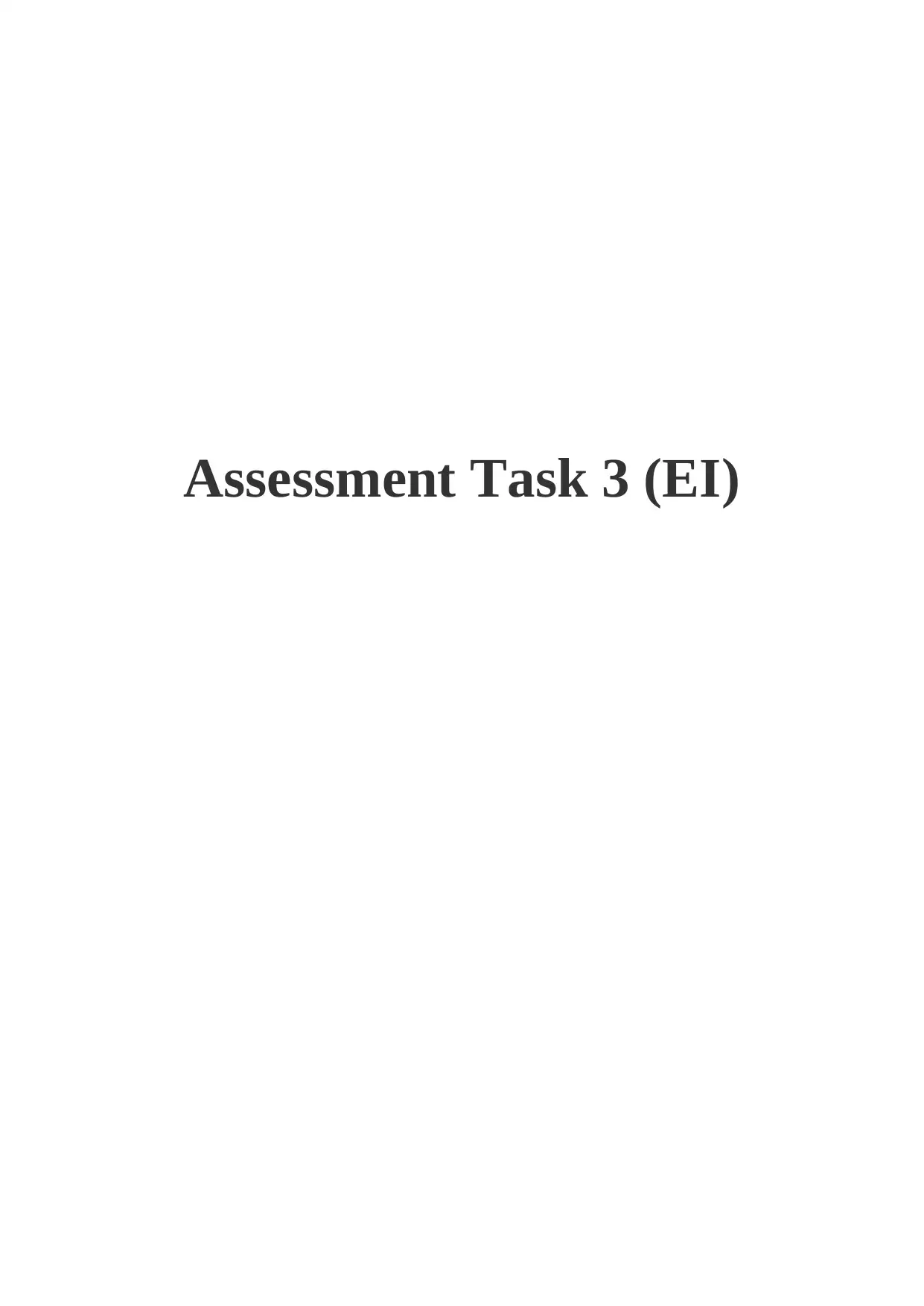
Assessment Task 3 (EI)
Paraphrase This Document
Need a fresh take? Get an instant paraphrase of this document with our AI Paraphraser
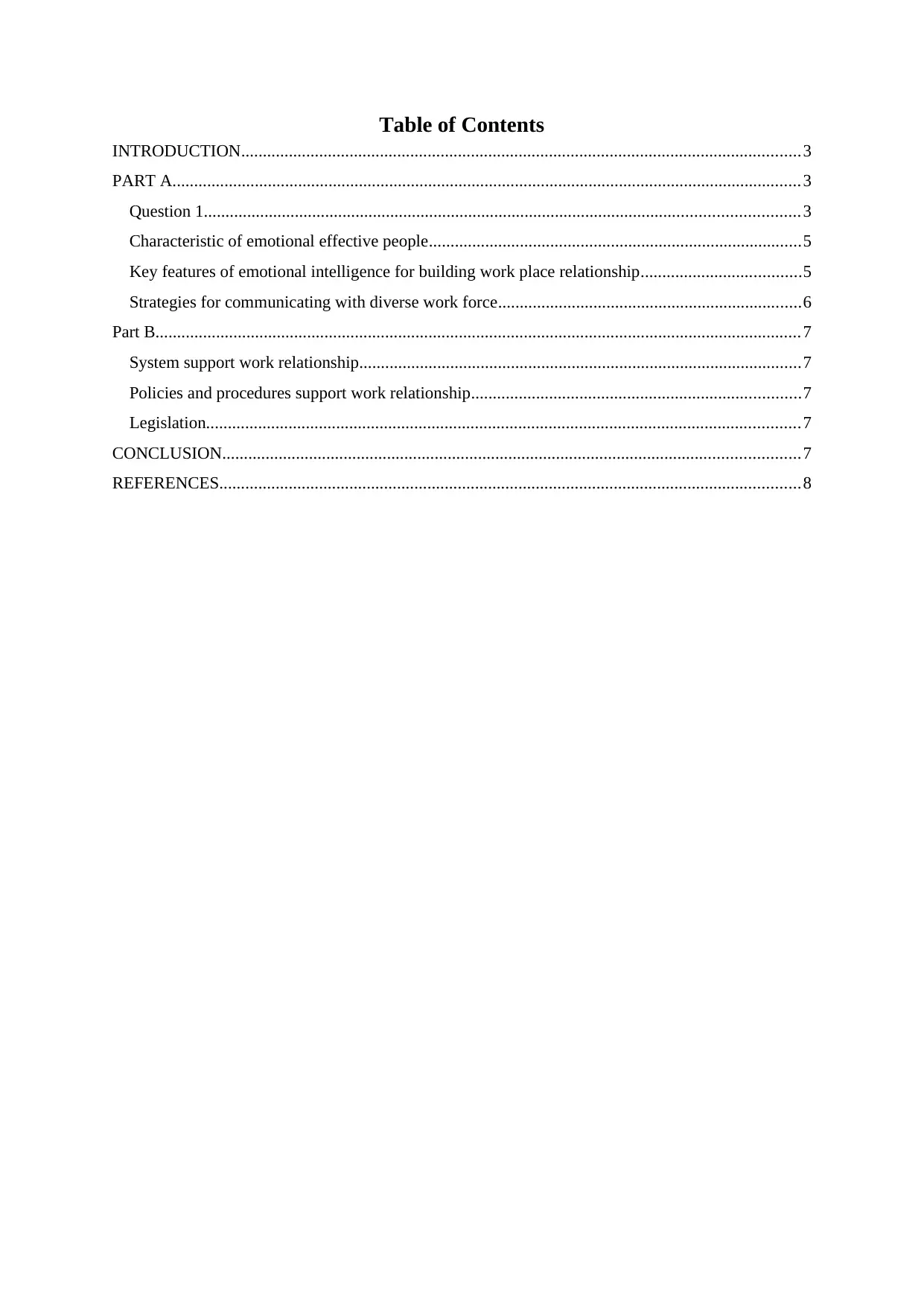
Table of Contents
INTRODUCTION.................................................................................................................................3
PART A.................................................................................................................................................3
Question 1.........................................................................................................................................3
Characteristic of emotional effective people......................................................................................5
Key features of emotional intelligence for building work place relationship.....................................5
Strategies for communicating with diverse work force......................................................................6
Part B.....................................................................................................................................................7
System support work relationship......................................................................................................7
Policies and procedures support work relationship............................................................................7
Legislation.........................................................................................................................................7
CONCLUSION.....................................................................................................................................7
REFERENCES......................................................................................................................................8
INTRODUCTION.................................................................................................................................3
PART A.................................................................................................................................................3
Question 1.........................................................................................................................................3
Characteristic of emotional effective people......................................................................................5
Key features of emotional intelligence for building work place relationship.....................................5
Strategies for communicating with diverse work force......................................................................6
Part B.....................................................................................................................................................7
System support work relationship......................................................................................................7
Policies and procedures support work relationship............................................................................7
Legislation.........................................................................................................................................7
CONCLUSION.....................................................................................................................................7
REFERENCES......................................................................................................................................8
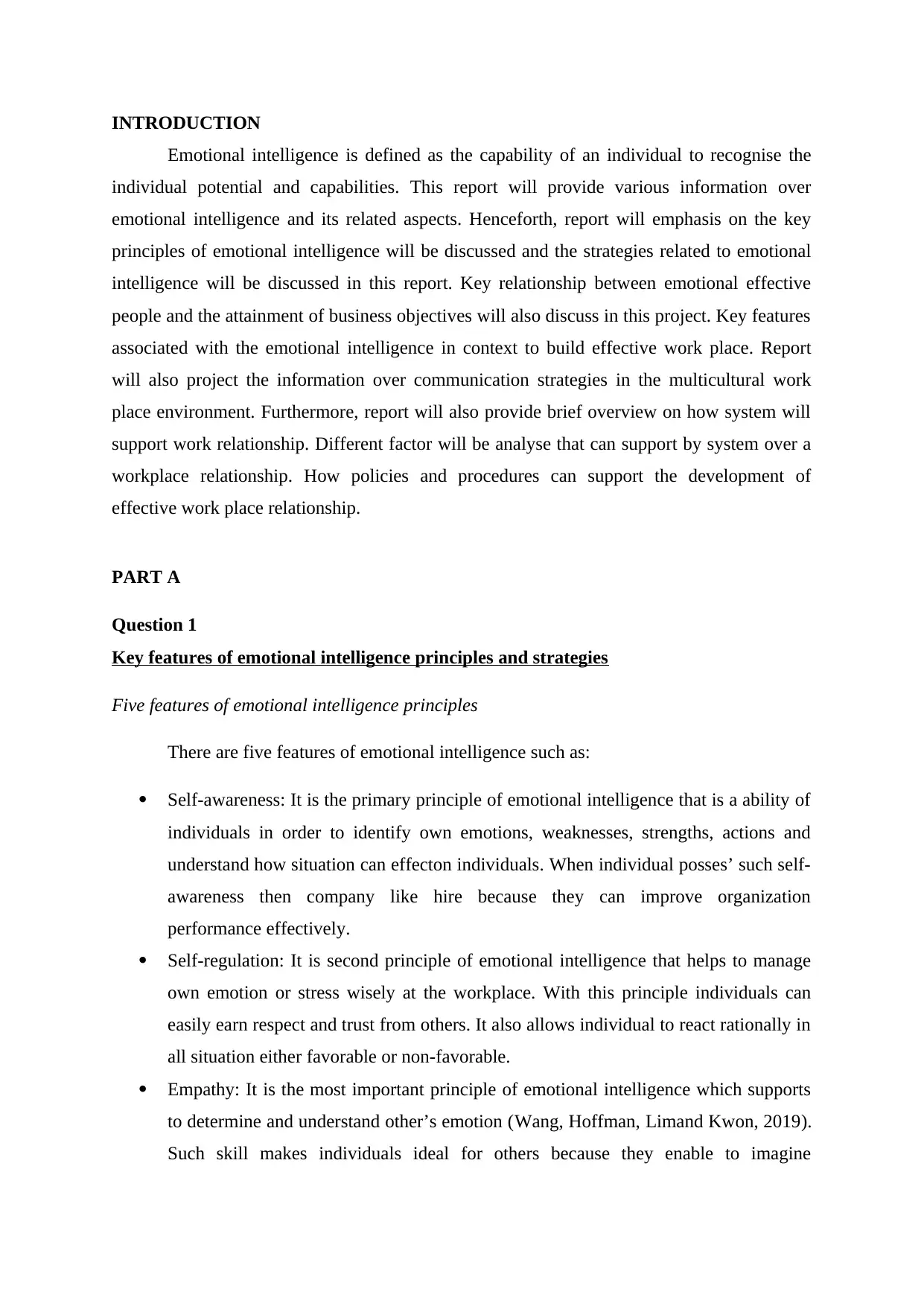
INTRODUCTION
Emotional intelligence is defined as the capability of an individual to recognise the
individual potential and capabilities. This report will provide various information over
emotional intelligence and its related aspects. Henceforth, report will emphasis on the key
principles of emotional intelligence will be discussed and the strategies related to emotional
intelligence will be discussed in this report. Key relationship between emotional effective
people and the attainment of business objectives will also discuss in this project. Key features
associated with the emotional intelligence in context to build effective work place. Report
will also project the information over communication strategies in the multicultural work
place environment. Furthermore, report will also provide brief overview on how system will
support work relationship. Different factor will be analyse that can support by system over a
workplace relationship. How policies and procedures can support the development of
effective work place relationship.
PART A
Question 1
Key features of emotional intelligence principles and strategies
Five features of emotional intelligence principles
There are five features of emotional intelligence such as:
Self-awareness: It is the primary principle of emotional intelligence that is a ability of
individuals in order to identify own emotions, weaknesses, strengths, actions and
understand how situation can effecton individuals. When individual posses’ such self-
awareness then company like hire because they can improve organization
performance effectively.
Self-regulation: It is second principle of emotional intelligence that helps to manage
own emotion or stress wisely at the workplace. With this principle individuals can
easily earn respect and trust from others. It also allows individual to react rationally in
all situation either favorable or non-favorable.
Empathy: It is the most important principle of emotional intelligence which supports
to determine and understand other’s emotion (Wang, Hoffman, Limand Kwon, 2019).
Such skill makes individuals ideal for others because they enable to imagine
Emotional intelligence is defined as the capability of an individual to recognise the
individual potential and capabilities. This report will provide various information over
emotional intelligence and its related aspects. Henceforth, report will emphasis on the key
principles of emotional intelligence will be discussed and the strategies related to emotional
intelligence will be discussed in this report. Key relationship between emotional effective
people and the attainment of business objectives will also discuss in this project. Key features
associated with the emotional intelligence in context to build effective work place. Report
will also project the information over communication strategies in the multicultural work
place environment. Furthermore, report will also provide brief overview on how system will
support work relationship. Different factor will be analyse that can support by system over a
workplace relationship. How policies and procedures can support the development of
effective work place relationship.
PART A
Question 1
Key features of emotional intelligence principles and strategies
Five features of emotional intelligence principles
There are five features of emotional intelligence such as:
Self-awareness: It is the primary principle of emotional intelligence that is a ability of
individuals in order to identify own emotions, weaknesses, strengths, actions and
understand how situation can effecton individuals. When individual posses’ such self-
awareness then company like hire because they can improve organization
performance effectively.
Self-regulation: It is second principle of emotional intelligence that helps to manage
own emotion or stress wisely at the workplace. With this principle individuals can
easily earn respect and trust from others. It also allows individual to react rationally in
all situation either favorable or non-favorable.
Empathy: It is the most important principle of emotional intelligence which supports
to determine and understand other’s emotion (Wang, Hoffman, Limand Kwon, 2019).
Such skill makes individuals ideal for others because they enable to imagine
⊘ This is a preview!⊘
Do you want full access?
Subscribe today to unlock all pages.

Trusted by 1+ million students worldwide
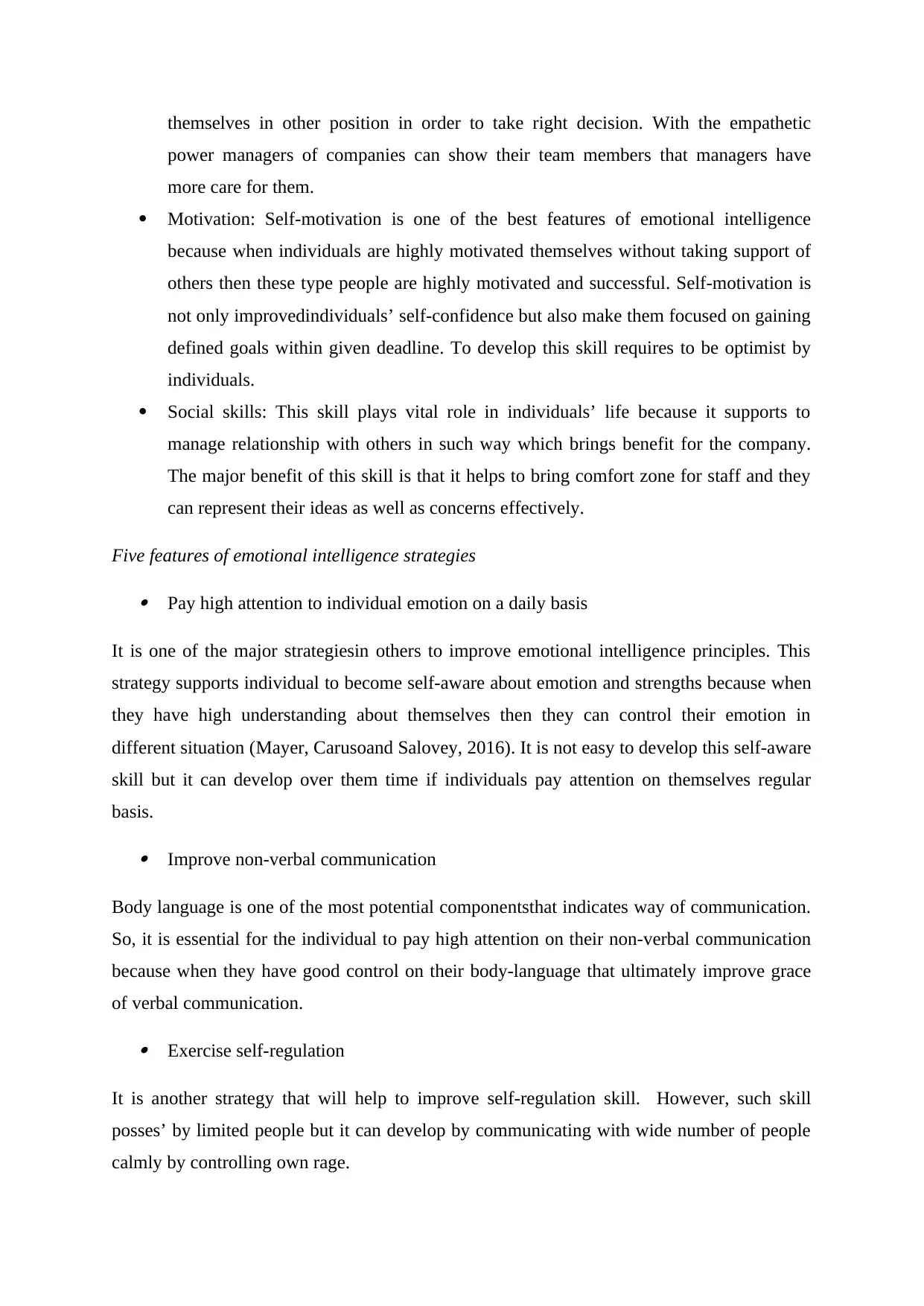
themselves in other position in order to take right decision. With the empathetic
power managers of companies can show their team members that managers have
more care for them.
Motivation: Self-motivation is one of the best features of emotional intelligence
because when individuals are highly motivated themselves without taking support of
others then these type people are highly motivated and successful. Self-motivation is
not only improvedindividuals’ self-confidence but also make them focused on gaining
defined goals within given deadline. To develop this skill requires to be optimist by
individuals.
Social skills: This skill plays vital role in individuals’ life because it supports to
manage relationship with others in such way which brings benefit for the company.
The major benefit of this skill is that it helps to bring comfort zone for staff and they
can represent their ideas as well as concerns effectively.
Five features of emotional intelligence strategies
Pay high attention to individual emotion on a daily basis
It is one of the major strategiesin others to improve emotional intelligence principles. This
strategy supports individual to become self-aware about emotion and strengths because when
they have high understanding about themselves then they can control their emotion in
different situation (Mayer, Carusoand Salovey, 2016). It is not easy to develop this self-aware
skill but it can develop over them time if individuals pay attention on themselves regular
basis.
Improve non-verbal communication
Body language is one of the most potential componentsthat indicates way of communication.
So, it is essential for the individual to pay high attention on their non-verbal communication
because when they have good control on their body-language that ultimately improve grace
of verbal communication.
Exercise self-regulation
It is another strategy that will help to improve self-regulation skill. However, such skill
posses’ by limited people but it can develop by communicating with wide number of people
calmly by controlling own rage.
power managers of companies can show their team members that managers have
more care for them.
Motivation: Self-motivation is one of the best features of emotional intelligence
because when individuals are highly motivated themselves without taking support of
others then these type people are highly motivated and successful. Self-motivation is
not only improvedindividuals’ self-confidence but also make them focused on gaining
defined goals within given deadline. To develop this skill requires to be optimist by
individuals.
Social skills: This skill plays vital role in individuals’ life because it supports to
manage relationship with others in such way which brings benefit for the company.
The major benefit of this skill is that it helps to bring comfort zone for staff and they
can represent their ideas as well as concerns effectively.
Five features of emotional intelligence strategies
Pay high attention to individual emotion on a daily basis
It is one of the major strategiesin others to improve emotional intelligence principles. This
strategy supports individual to become self-aware about emotion and strengths because when
they have high understanding about themselves then they can control their emotion in
different situation (Mayer, Carusoand Salovey, 2016). It is not easy to develop this self-aware
skill but it can develop over them time if individuals pay attention on themselves regular
basis.
Improve non-verbal communication
Body language is one of the most potential componentsthat indicates way of communication.
So, it is essential for the individual to pay high attention on their non-verbal communication
because when they have good control on their body-language that ultimately improve grace
of verbal communication.
Exercise self-regulation
It is another strategy that will help to improve self-regulation skill. However, such skill
posses’ by limited people but it can develop by communicating with wide number of people
calmly by controlling own rage.
Paraphrase This Document
Need a fresh take? Get an instant paraphrase of this document with our AI Paraphraser
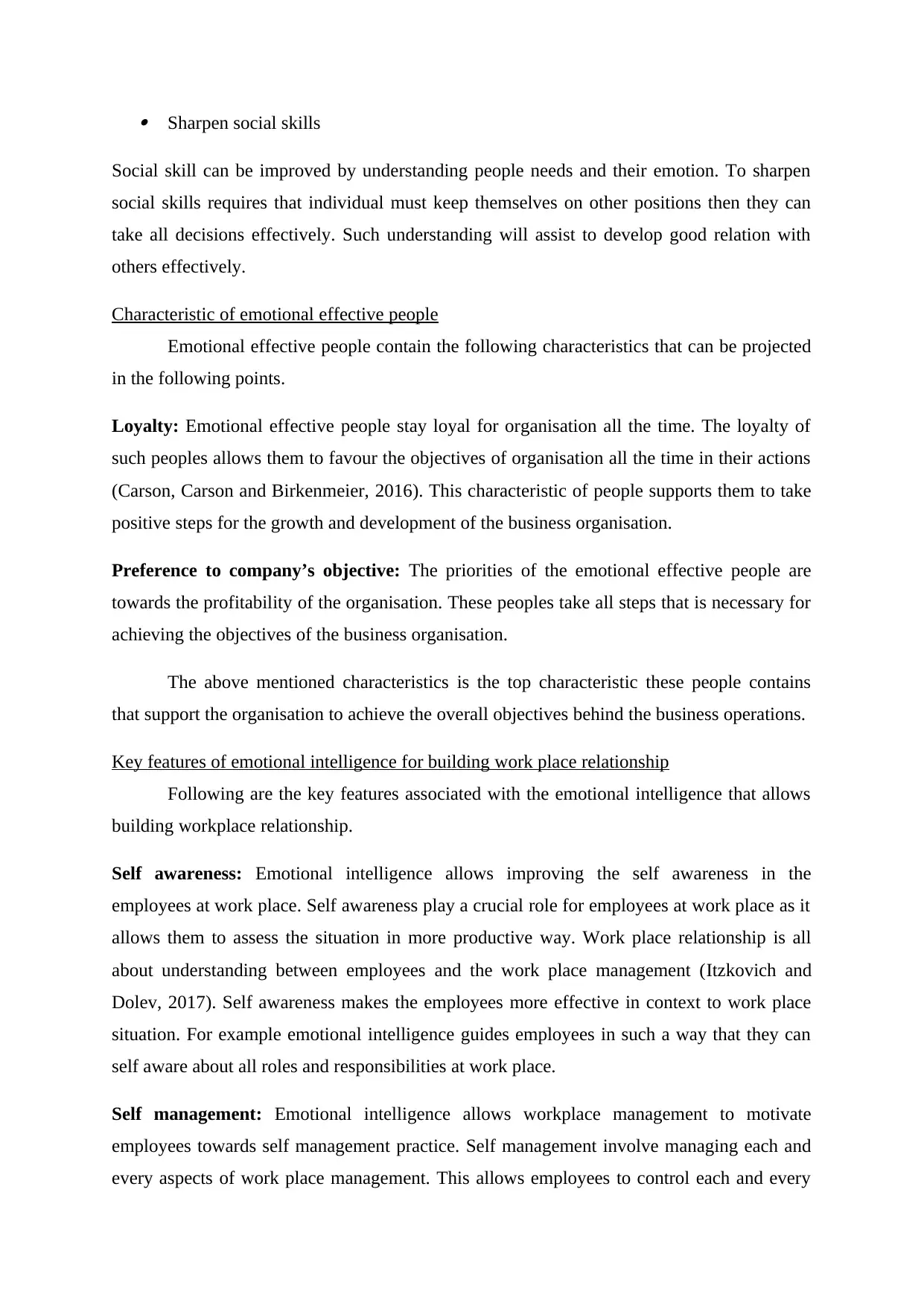
Sharpen social skills
Social skill can be improved by understanding people needs and their emotion. To sharpen
social skills requires that individual must keep themselves on other positions then they can
take all decisions effectively. Such understanding will assist to develop good relation with
others effectively.
Characteristic of emotional effective people
Emotional effective people contain the following characteristics that can be projected
in the following points.
Loyalty: Emotional effective people stay loyal for organisation all the time. The loyalty of
such peoples allows them to favour the objectives of organisation all the time in their actions
(Carson, Carson and Birkenmeier, 2016). This characteristic of people supports them to take
positive steps for the growth and development of the business organisation.
Preference to company’s objective: The priorities of the emotional effective people are
towards the profitability of the organisation. These peoples take all steps that is necessary for
achieving the objectives of the business organisation.
The above mentioned characteristics is the top characteristic these people contains
that support the organisation to achieve the overall objectives behind the business operations.
Key features of emotional intelligence for building work place relationship
Following are the key features associated with the emotional intelligence that allows
building workplace relationship.
Self awareness: Emotional intelligence allows improving the self awareness in the
employees at work place. Self awareness play a crucial role for employees at work place as it
allows them to assess the situation in more productive way. Work place relationship is all
about understanding between employees and the work place management (Itzkovich and
Dolev, 2017). Self awareness makes the employees more effective in context to work place
situation. For example emotional intelligence guides employees in such a way that they can
self aware about all roles and responsibilities at work place.
Self management: Emotional intelligence allows workplace management to motivate
employees towards self management practice. Self management involve managing each and
every aspects of work place management. This allows employees to control each and every
Social skill can be improved by understanding people needs and their emotion. To sharpen
social skills requires that individual must keep themselves on other positions then they can
take all decisions effectively. Such understanding will assist to develop good relation with
others effectively.
Characteristic of emotional effective people
Emotional effective people contain the following characteristics that can be projected
in the following points.
Loyalty: Emotional effective people stay loyal for organisation all the time. The loyalty of
such peoples allows them to favour the objectives of organisation all the time in their actions
(Carson, Carson and Birkenmeier, 2016). This characteristic of people supports them to take
positive steps for the growth and development of the business organisation.
Preference to company’s objective: The priorities of the emotional effective people are
towards the profitability of the organisation. These peoples take all steps that is necessary for
achieving the objectives of the business organisation.
The above mentioned characteristics is the top characteristic these people contains
that support the organisation to achieve the overall objectives behind the business operations.
Key features of emotional intelligence for building work place relationship
Following are the key features associated with the emotional intelligence that allows
building workplace relationship.
Self awareness: Emotional intelligence allows improving the self awareness in the
employees at work place. Self awareness play a crucial role for employees at work place as it
allows them to assess the situation in more productive way. Work place relationship is all
about understanding between employees and the work place management (Itzkovich and
Dolev, 2017). Self awareness makes the employees more effective in context to work place
situation. For example emotional intelligence guides employees in such a way that they can
self aware about all roles and responsibilities at work place.
Self management: Emotional intelligence allows workplace management to motivate
employees towards self management practice. Self management involve managing each and
every aspects of work place management. This allows employees to control each and every
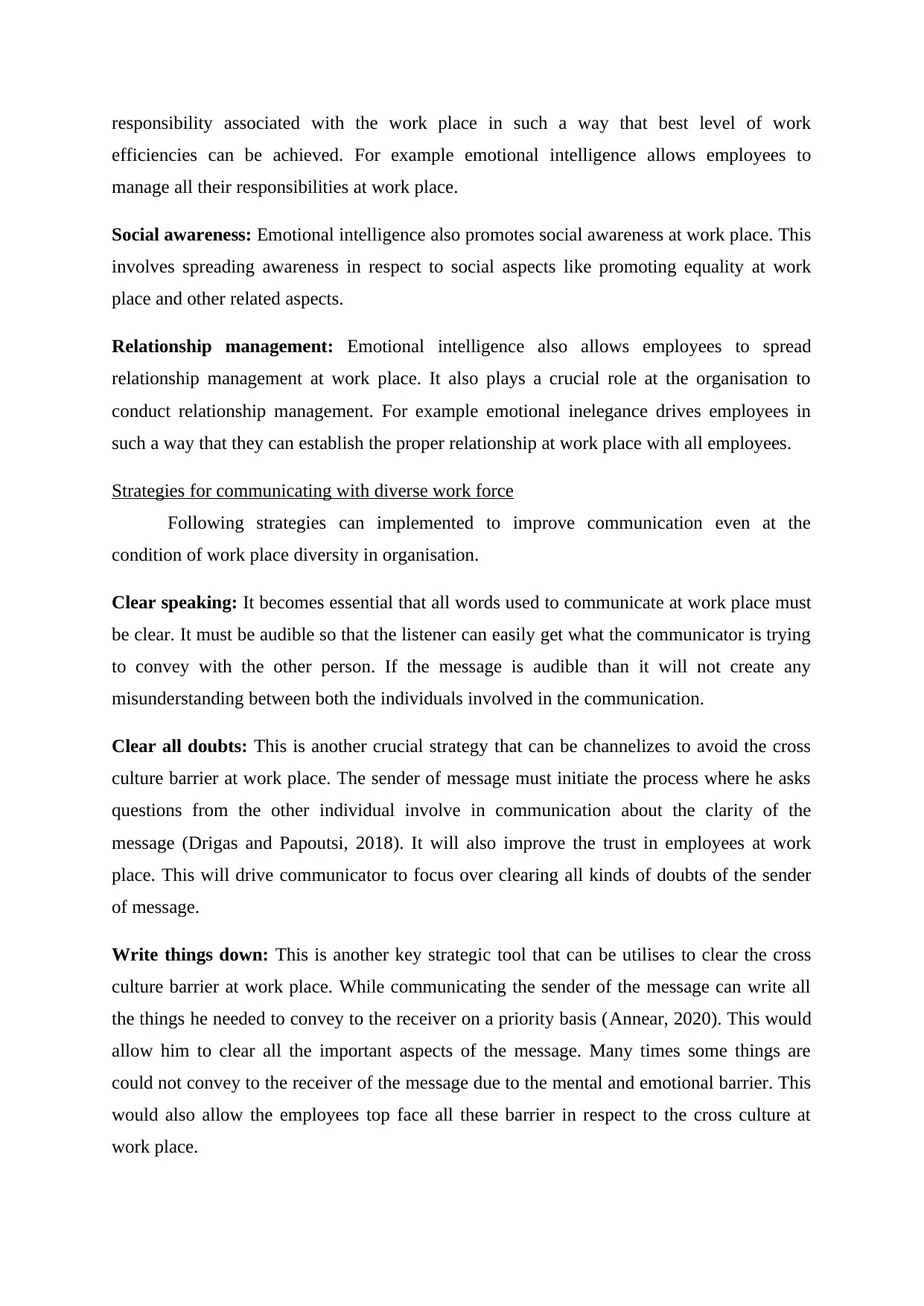
responsibility associated with the work place in such a way that best level of work
efficiencies can be achieved. For example emotional intelligence allows employees to
manage all their responsibilities at work place.
Social awareness: Emotional intelligence also promotes social awareness at work place. This
involves spreading awareness in respect to social aspects like promoting equality at work
place and other related aspects.
Relationship management: Emotional intelligence also allows employees to spread
relationship management at work place. It also plays a crucial role at the organisation to
conduct relationship management. For example emotional inelegance drives employees in
such a way that they can establish the proper relationship at work place with all employees.
Strategies for communicating with diverse work force
Following strategies can implemented to improve communication even at the
condition of work place diversity in organisation.
Clear speaking: It becomes essential that all words used to communicate at work place must
be clear. It must be audible so that the listener can easily get what the communicator is trying
to convey with the other person. If the message is audible than it will not create any
misunderstanding between both the individuals involved in the communication.
Clear all doubts: This is another crucial strategy that can be channelizes to avoid the cross
culture barrier at work place. The sender of message must initiate the process where he asks
questions from the other individual involve in communication about the clarity of the
message (Drigas and Papoutsi, 2018). It will also improve the trust in employees at work
place. This will drive communicator to focus over clearing all kinds of doubts of the sender
of message.
Write things down: This is another key strategic tool that can be utilises to clear the cross
culture barrier at work place. While communicating the sender of the message can write all
the things he needed to convey to the receiver on a priority basis (Annear, 2020). This would
allow him to clear all the important aspects of the message. Many times some things are
could not convey to the receiver of the message due to the mental and emotional barrier. This
would also allow the employees top face all these barrier in respect to the cross culture at
work place.
efficiencies can be achieved. For example emotional intelligence allows employees to
manage all their responsibilities at work place.
Social awareness: Emotional intelligence also promotes social awareness at work place. This
involves spreading awareness in respect to social aspects like promoting equality at work
place and other related aspects.
Relationship management: Emotional intelligence also allows employees to spread
relationship management at work place. It also plays a crucial role at the organisation to
conduct relationship management. For example emotional inelegance drives employees in
such a way that they can establish the proper relationship at work place with all employees.
Strategies for communicating with diverse work force
Following strategies can implemented to improve communication even at the
condition of work place diversity in organisation.
Clear speaking: It becomes essential that all words used to communicate at work place must
be clear. It must be audible so that the listener can easily get what the communicator is trying
to convey with the other person. If the message is audible than it will not create any
misunderstanding between both the individuals involved in the communication.
Clear all doubts: This is another crucial strategy that can be channelizes to avoid the cross
culture barrier at work place. The sender of message must initiate the process where he asks
questions from the other individual involve in communication about the clarity of the
message (Drigas and Papoutsi, 2018). It will also improve the trust in employees at work
place. This will drive communicator to focus over clearing all kinds of doubts of the sender
of message.
Write things down: This is another key strategic tool that can be utilises to clear the cross
culture barrier at work place. While communicating the sender of the message can write all
the things he needed to convey to the receiver on a priority basis (Annear, 2020). This would
allow him to clear all the important aspects of the message. Many times some things are
could not convey to the receiver of the message due to the mental and emotional barrier. This
would also allow the employees top face all these barrier in respect to the cross culture at
work place.
⊘ This is a preview!⊘
Do you want full access?
Subscribe today to unlock all pages.

Trusted by 1+ million students worldwide
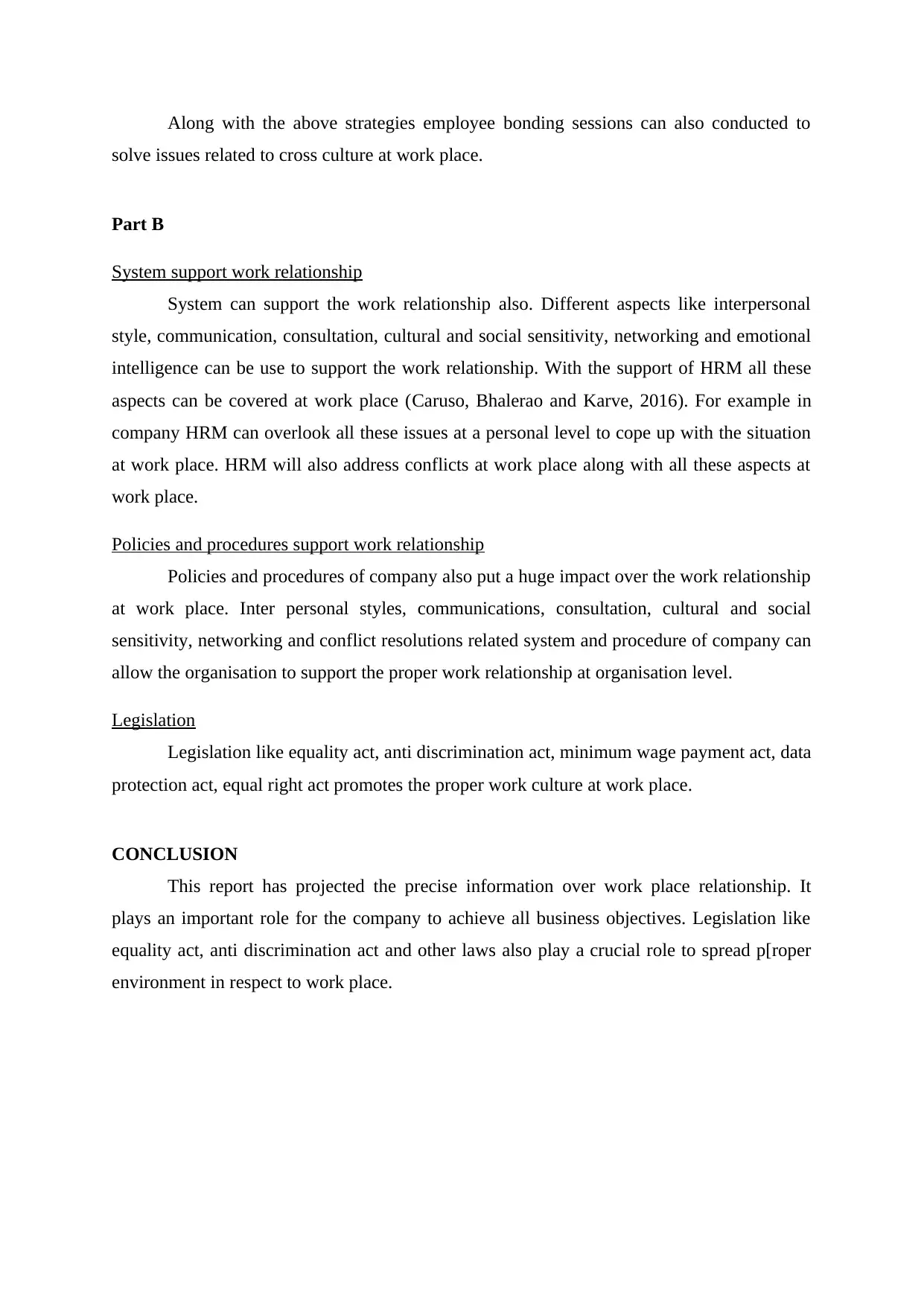
Along with the above strategies employee bonding sessions can also conducted to
solve issues related to cross culture at work place.
Part B
System support work relationship
System can support the work relationship also. Different aspects like interpersonal
style, communication, consultation, cultural and social sensitivity, networking and emotional
intelligence can be use to support the work relationship. With the support of HRM all these
aspects can be covered at work place (Caruso, Bhalerao and Karve, 2016). For example in
company HRM can overlook all these issues at a personal level to cope up with the situation
at work place. HRM will also address conflicts at work place along with all these aspects at
work place.
Policies and procedures support work relationship
Policies and procedures of company also put a huge impact over the work relationship
at work place. Inter personal styles, communications, consultation, cultural and social
sensitivity, networking and conflict resolutions related system and procedure of company can
allow the organisation to support the proper work relationship at organisation level.
Legislation
Legislation like equality act, anti discrimination act, minimum wage payment act, data
protection act, equal right act promotes the proper work culture at work place.
CONCLUSION
This report has projected the precise information over work place relationship. It
plays an important role for the company to achieve all business objectives. Legislation like
equality act, anti discrimination act and other laws also play a crucial role to spread p[roper
environment in respect to work place.
solve issues related to cross culture at work place.
Part B
System support work relationship
System can support the work relationship also. Different aspects like interpersonal
style, communication, consultation, cultural and social sensitivity, networking and emotional
intelligence can be use to support the work relationship. With the support of HRM all these
aspects can be covered at work place (Caruso, Bhalerao and Karve, 2016). For example in
company HRM can overlook all these issues at a personal level to cope up with the situation
at work place. HRM will also address conflicts at work place along with all these aspects at
work place.
Policies and procedures support work relationship
Policies and procedures of company also put a huge impact over the work relationship
at work place. Inter personal styles, communications, consultation, cultural and social
sensitivity, networking and conflict resolutions related system and procedure of company can
allow the organisation to support the proper work relationship at organisation level.
Legislation
Legislation like equality act, anti discrimination act, minimum wage payment act, data
protection act, equal right act promotes the proper work culture at work place.
CONCLUSION
This report has projected the precise information over work place relationship. It
plays an important role for the company to achieve all business objectives. Legislation like
equality act, anti discrimination act and other laws also play a crucial role to spread p[roper
environment in respect to work place.
Paraphrase This Document
Need a fresh take? Get an instant paraphrase of this document with our AI Paraphraser
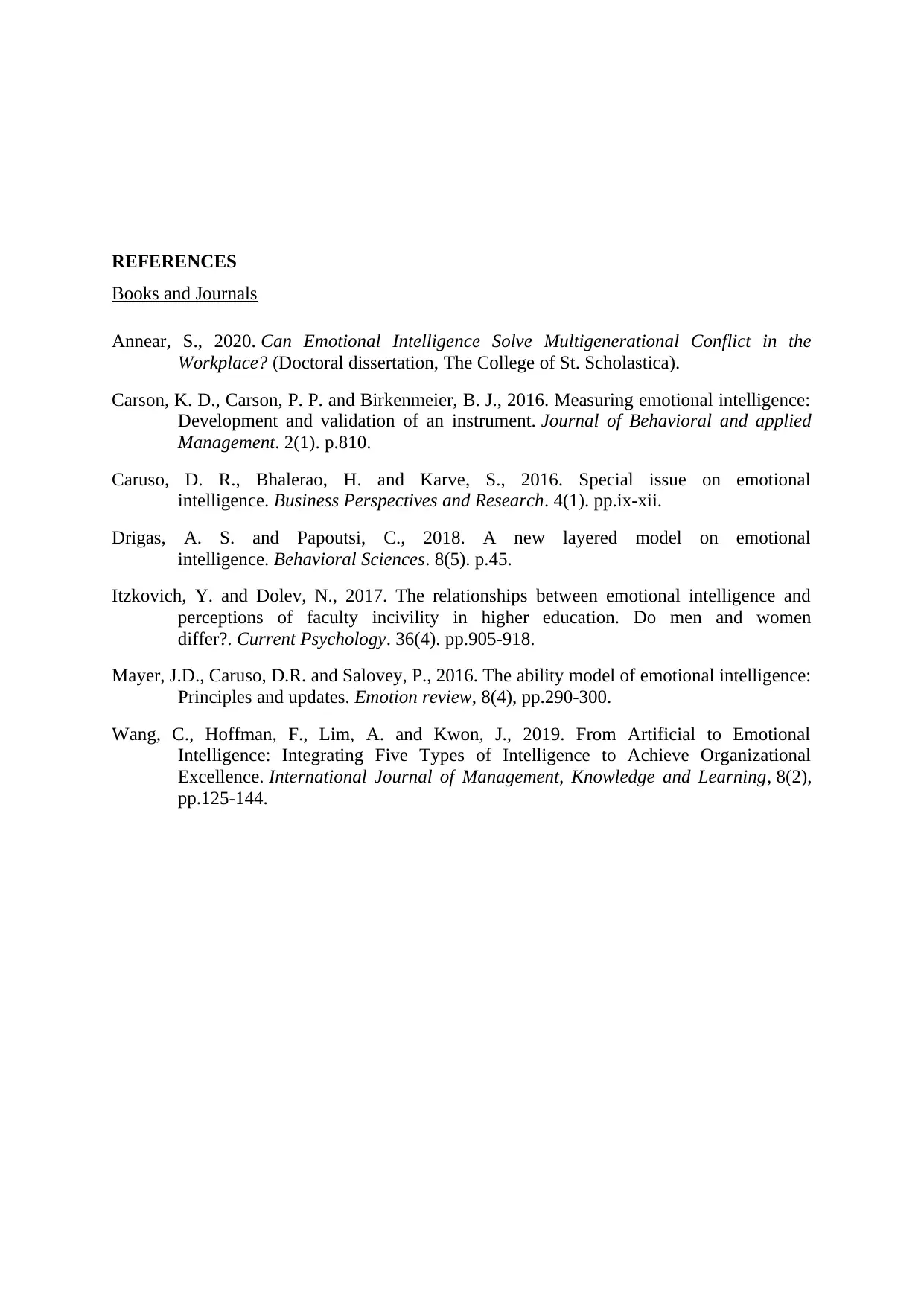
REFERENCES
Books and Journals
Annear, S., 2020. Can Emotional Intelligence Solve Multigenerational Conflict in the
Workplace? (Doctoral dissertation, The College of St. Scholastica).
Carson, K. D., Carson, P. P. and Birkenmeier, B. J., 2016. Measuring emotional intelligence:
Development and validation of an instrument. Journal of Behavioral and applied
Management. 2(1). p.810.
Caruso, D. R., Bhalerao, H. and Karve, S., 2016. Special issue on emotional
intelligence. Business Perspectives and Research. 4(1). pp.ix-xii.
Drigas, A. S. and Papoutsi, C., 2018. A new layered model on emotional
intelligence. Behavioral Sciences. 8(5). p.45.
Itzkovich, Y. and Dolev, N., 2017. The relationships between emotional intelligence and
perceptions of faculty incivility in higher education. Do men and women
differ?. Current Psychology. 36(4). pp.905-918.
Mayer, J.D., Caruso, D.R. and Salovey, P., 2016. The ability model of emotional intelligence:
Principles and updates. Emotion review, 8(4), pp.290-300.
Wang, C., Hoffman, F., Lim, A. and Kwon, J., 2019. From Artificial to Emotional
Intelligence: Integrating Five Types of Intelligence to Achieve Organizational
Excellence. International Journal of Management, Knowledge and Learning, 8(2),
pp.125-144.
Books and Journals
Annear, S., 2020. Can Emotional Intelligence Solve Multigenerational Conflict in the
Workplace? (Doctoral dissertation, The College of St. Scholastica).
Carson, K. D., Carson, P. P. and Birkenmeier, B. J., 2016. Measuring emotional intelligence:
Development and validation of an instrument. Journal of Behavioral and applied
Management. 2(1). p.810.
Caruso, D. R., Bhalerao, H. and Karve, S., 2016. Special issue on emotional
intelligence. Business Perspectives and Research. 4(1). pp.ix-xii.
Drigas, A. S. and Papoutsi, C., 2018. A new layered model on emotional
intelligence. Behavioral Sciences. 8(5). p.45.
Itzkovich, Y. and Dolev, N., 2017. The relationships between emotional intelligence and
perceptions of faculty incivility in higher education. Do men and women
differ?. Current Psychology. 36(4). pp.905-918.
Mayer, J.D., Caruso, D.R. and Salovey, P., 2016. The ability model of emotional intelligence:
Principles and updates. Emotion review, 8(4), pp.290-300.
Wang, C., Hoffman, F., Lim, A. and Kwon, J., 2019. From Artificial to Emotional
Intelligence: Integrating Five Types of Intelligence to Achieve Organizational
Excellence. International Journal of Management, Knowledge and Learning, 8(2),
pp.125-144.
1 out of 8
Related Documents
Your All-in-One AI-Powered Toolkit for Academic Success.
+13062052269
info@desklib.com
Available 24*7 on WhatsApp / Email
![[object Object]](/_next/static/media/star-bottom.7253800d.svg)
Unlock your academic potential
Copyright © 2020–2025 A2Z Services. All Rights Reserved. Developed and managed by ZUCOL.



